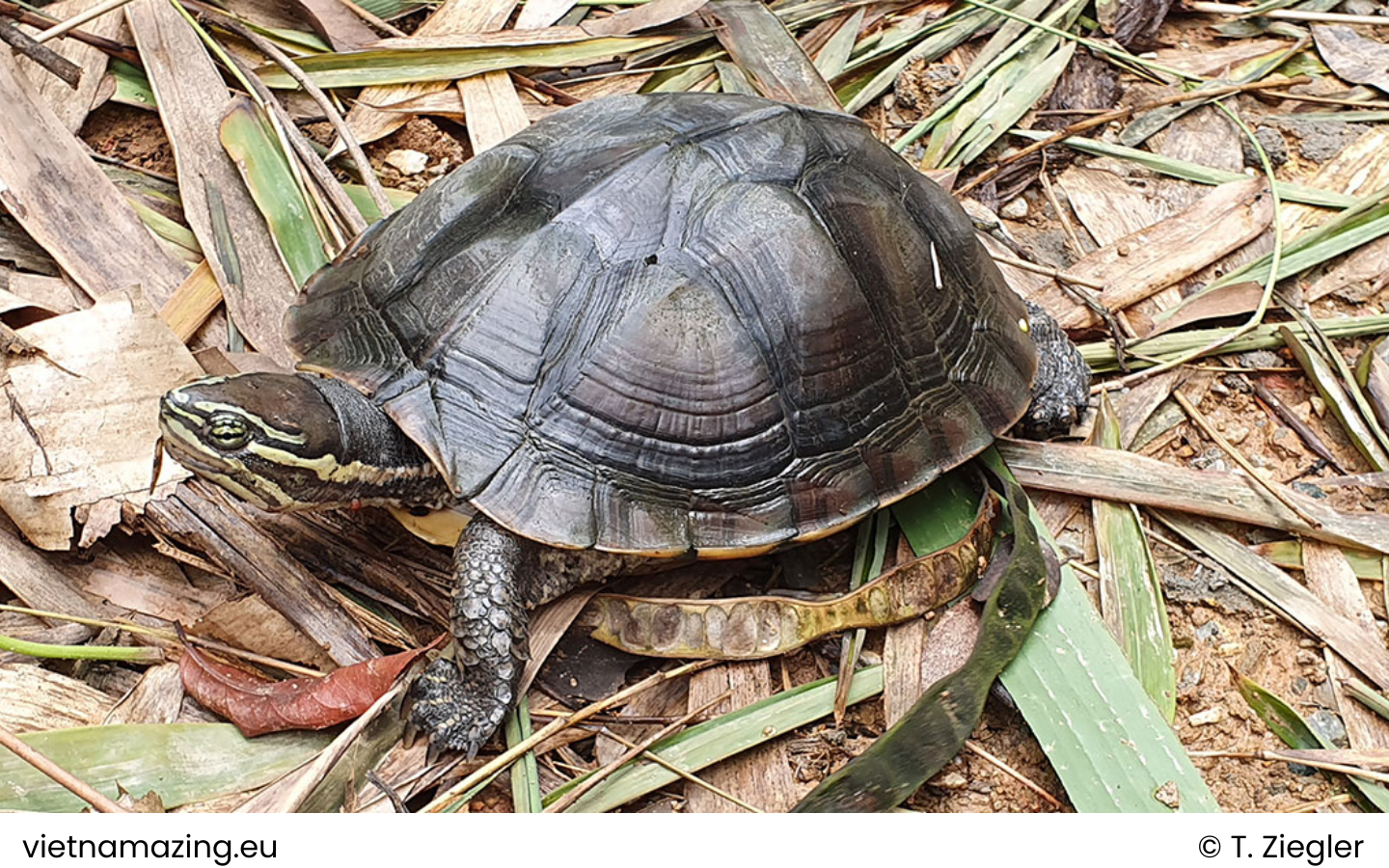
Science name: Mauremys annamensis – (Siebenrock, 1903)
Taxonomic: Animalia>> Chordata>> Reptilia>> Testudines >> Geoemydidae >> annamensis
Species status: Endemic ; IUCN status: CR (Critically Endangered Species)
Description:
Physical Characteristics:
The Vietnamese Pond Turtle has a moderately large carapace, with females reaching up to 28.5 cm and males up to 23.2 cm in length. The carapace is relatively flat with three distinct ridges (keels) running along its length.
The head is dark brown or black, with three yellow stripes running on each side: one stripe from the nose to above the eye, another larger stripe from the nose to the ear, and one along the lower jaw.
The carapace is dark grey or brown, while the plastron (underside) is yellow or orange, featuring large black blotches on each scute.
Coloration and Appearance:
The species has a dark upper body, with lighter undersides that contrast with the dark shell. The three yellow stripes on the head are distinctive, helping to identify the species.
Distribution and habitat:
Elevation: This species is found at elevations up to 150 meters above sea level.
Area: Mauremys annamensis is endemic to central Vietnam. It occurs in a narrow strip of coastal lowlands between the South China Sea to the east and the Annamite Mountains to the west, with recorded populations in Quang Nam, Da Nang, and Gia Lai Provinces.
Habitat: It inhabits freshwater wetlands such as marshes, slow-moving streams, small lakes, ponds, and riparian areas of large rivers. It has also been recorded in rice fields and around village ponds. The species prefers areas with still or slow-moving water and may also be found in seasonally flooded agricultural land.
Behaviour and ecology:
Lifestyle:
Mauremys annamensis is nocturnal and primarily aquatic, spending most of its time in or near water. It is a generalist omnivore, with a preference for carnivorous food items such as insects, worms, and fish, although it also consumes aquatic plants.
The species is known to estivate during the dry season by burrowing into the leaf litter at the base of bamboo stands.
Reproduction:
The species is oviparous, laying eggs in clutches. In captivity, females have been known to lay between five to eight eggs, and up to two clutches per year. However, wild reproductive data are sparse due to the species’ rarity in its natural habitat.
Conservation and status:
IUCN Red List Category and Criteria:
Critically Endangered (CR) under criteria A2bcd+4bcd; B2ab(i,ii,iii,iv,v); D due to a drastic decline in population and habitat loss.
Population Trend:
The population of Mauremys annamensis is decreasing, with an estimated 99% reduction over the past 30–45 years. It is believed that fewer than 50 mature individuals remain in the wild.
Threats:
The species is critically endangered due to habitat loss, primarily caused by agricultural expansion, pollution, and the collection of turtles for the pet trade and traditional medicine. The species has been heavily exploited in the illegal wildlife trade, with significant population declines since the 1980s.
Conservation Actions:
Mauremys annamensis is protected under Vietnamese law, and conservation efforts are underway to protect its remaining habitats. The species is also part of a captive breeding program in the Turtle Conservation Centre in Cuc Phuong National Park. However, continued habitat destruction and illegal trade pose significant challenges to its recovery. Further research into its population, habitat needs, and reproduction is necessary to guide future conservation actions.
Crocodile Trail – The Best Birding Trail in Cat Tien National Park
If you’re a birder or nature photographer planning a trip to Vietnam, few places offer [...]
Cong Troi Trail – Top 1 Dalat Plateau Birding Trail Experience
If you’re a birder or nature photographer planning a trip to Vietnam’s Central Highlands, the [...]
How to Identify the Greater Sand Plover, Tibetan Sand Plover and Siberian Sand Plover
Identification Differences within the Sand Plover Complex: The sand plover group, which was traditionally divided [...]
Highlights of Cat Tien National Park Reptiles and Amphibian Endemics
Spanning over 71,350 hectares of tropical forests, grasslands, and wetlands, Cat Tien National Park is [...]
Highlights of Cat Tien National Park Mammals in a World Biosphere Reserve
In addition to reptiles and birds, Cat Tien National Park is also rich in mammals, [...]
Kontum Plateau Endemic and Highlight bird
Kontum Plateau Endemic And Highlight Bird species like Chestnut-eared Laughingthrush and top birding routes while [...]